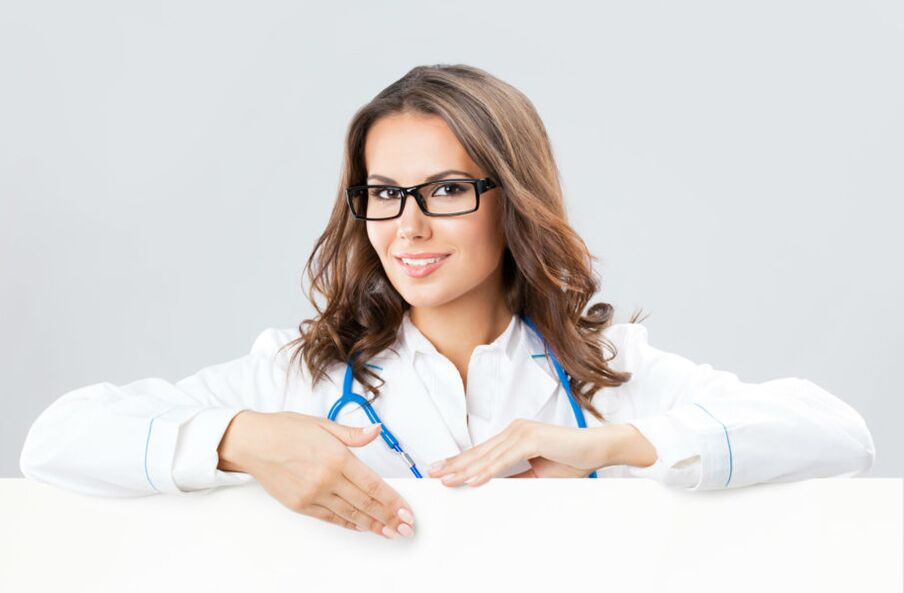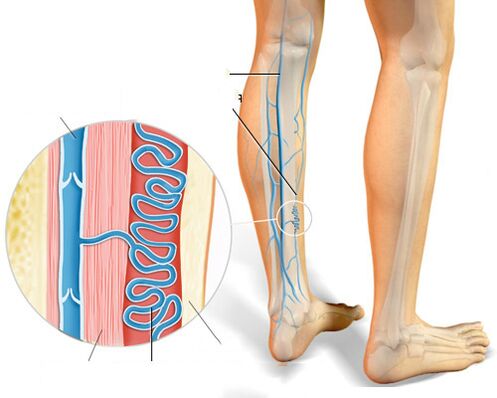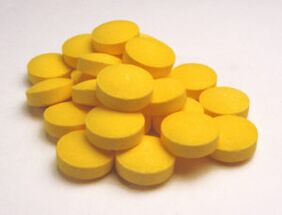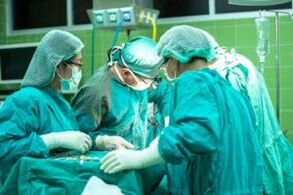
Varicose veins are a very common pathology that significantly reduces quality of life and leads to dangerous complications, requiring expensive and complex treatment.
What are varicose veins?
Varicose veins, or varicose veins, are a condition associated with the destruction of the valvular apparatus in the veins.As a result of their damage, the normal outflow of blood from the periphery is disrupted, and blood stagnates in various parts of the vascular bed, causing them to dilate.
The main susceptible group to the disease is people over 40 years old.This is because blood vessels are subject to various negative influences at this time, resulting in a decrease in their ability to adapt.
Most commonly, varicose veins affect the lower limbs, but the pathological process can also be observed in the groin area or in internal organs.
It is necessary to take preventive measures, since this pathology tends to progress, and the treatment options for varicose veins are quite complex.

reason
The main causes of varicose veins are thought to be overactivity and underactivity.The mechanism of normal blood flow in veins is closely related to muscle contraction.During muscle tension, blood is pushed into the veins, and valves in the venous cavities prevent blood from flowing back.
Lack of physical activity can lead to peripheral congestion, causing blood to put excessive pressure on the valve mechanism.Excessive pressure can also adversely affect the vascular system.Frequent muscle contractions may cause damage to the vein valves.
In addition, there are some negative factors and diseases that increase the risk of developing varicose veins:
- bad habits.Alcohol and nicotine have vasomotor properties.They can dilate and narrow the lumen of blood vessels, causing disruption of normal blood flow.
- Abuse of coffee.
- The shoes are uncomfortable.
- Genetic predisposition.
- Systemic connective tissue diseases.
- Atherosclerosis.
- diabetes.
- Traumatic lesions.
- Being overweight.
The presence of these factors greatly increases the risk of developing this disease.Regardless of the cause, the symptoms of varicose veins in the lower extremities are not different.
clinical manifestations
Typically, symptoms of this disease appear when the veins of the lower extremities have already undergone irreversible structural changes.In other words, the patient already needs surgical treatment when contacting the doctor.

In the early stages, varicose veins may be asymptomatic.Some patients complain of mild soreness after prolonged walking or running.There are no specific symptoms to make a diagnosis.The initial form of varicose veins can only be detected through instrumental examination.
Symptoms of developing varicose veins are as follows:
- Cyanosis occurs, localized to the veins.
- Blood vessels protrude from the surface of the skin and form nodules.These structures are painful and dense, which is associated with inflammation and connective tissue proliferative processes (sclerosis) in these areas.
- Persistent pain that is not dependent on physical activity.If in the initial stages of the development of the pathology it occurs only after overexertion, then in later stages it can trouble the patient even during sleep.This is because one of the symptoms of inflammation is pain.The intensity of the pain can be so severe that it can lead to lameness.
- The local temperature in the node area increases.
The first symptoms of the disease require immediate contact with a medical facility for diagnosis and treatment.
Why are varicose veins dangerous?
Lack of proper treatment can lead to the development of many dangerous complications that pose not only a threat to health but also to life.These include:
- Thrombophlebitis.In areas of inflamed veins, blood flow slows down significantly.This condition favors the formation of thrombus.These blood clots can block the lumen of blood vessels in the lower limbs, causing gangrene, or they can travel with the blood to the lungs, heart, brain, and other organs, causing a dramatic interruption in the blood supply.These conditions are extremely difficult to treat and often lead to disability and death.
- Nutritional ulcer.Infringement of blood venous outflow is always accompanied by disorder of microcirculation of lower limb tissues.A lack of oxygen and nutrients can lead to the formation of ulcers.These ulcers are difficult to treat and often recur, as it is necessary to treat the underlying cause of their appearance.
- bleed.If varicose veins are accompanied by high blood pressure, they can cause peripheral blood vessels to rupture and bleed.This is because dilated blood vessels become thinner, and high blood pressure can cause them to rupture.In addition, minor mechanical trauma can cause bleeding, which in healthy people does not even lead to hematoma formation.
Almost all complications are exacerbated by the addition of infectious factors, significantly worsening the condition and complicating treatment.
If complications arise, treatment of varicose veins should be reconsidered.
diagnosis
If varicose veins are suspected, the patient must undergo a series of tests, the purpose of which is to confirm the diagnosis and evaluate the condition of the tissue surrounding the pathological focus.
For this purpose, it is recommended to carry out the following checks:
- General blood tests.
- Biochemistry of blood.
- Coagulation diagram.This laboratory test can predict the development of thrombosis and thrombophlebitis based on the clotting properties of the blood.High coagulability is a dangerous condition.
- ultrasound.Using ultrasound, you can obtain detailed images of the vascular bed and identify foci of inflammation that do not appear externally.
- Venography.Obtaining graphic images of the venous system of the lower limbs using contrast media allows you to study its structure in detail and identify the smallest changes.
In addition to instrumental and laboratory studies, specific tests are performed to evaluate the condition of the soft tissues and assess the degree of circulatory failure.
An external examination is also important, during which the doctor can see specific external manifestations, possible localization, and trophic ulcers.
Phlebologists should be involved in the treatment and supervision of patients with such disorders.This doctor specializes in treating varicose veins.
treat
Varicose veins in the lower extremities can be treated with medication or surgical intervention.The choice of treatment depends on the severity of the changes in the affected area.
Medical treatment of varicose veins of the lower limbs is carried out according to a special protocol that takes into account the influence on the pathological process and prevents the occurrence of complications.
Surgical treatment of varicose veins is the most effective, as it allows you to permanently get rid of the pathological condition.However, not all patients allow this and there are many contraindications.
Conservative treatment

Treatment of varicose veins without surgery is only allowed in the early stages of pathological progression.
It is worth remembering that conservative treatment can only help eliminate the manifestations of the disease.It is impossible to achieve lasting results using medications alone.They only work for a certain period of time and cannot stop the progression of the disease.
The following groups of medications are recommended for patients with varicose veins:
- NSAIDs.Topical use of NSAIDs in ointment form is recommended.In some cases, these drugs may be prescribed in tablet form, but long-term treatment may cause gastritis or peptic ulcers as a side effect.
- Antiplatelet agents.These medications work to prevent blood clots.The original representative was considered regular aspirin used in small doses.They thin the blood and help improve blood flow through inflamed veins.The use of such drugs is not acceptable in patients with a bleeding tendency.
- Hormones in the prednisolone group.If NSAIDs do not have the desired effect, adrenal hormones may be used.These substances are also used in the form of ointments.They have significant anti-inflammatory effects and can also improve tissue microcirculation.It is worth remembering that long-term use of hormones can also have a negative impact on physical conditions.
- Intravenous Infusion.This group of drugs is used to treat varicose veins in the lower limbs.They normalize the tension in blood vessel walls, thus ensuring normal blood flow.
Treatment of varicose veins should be systematic.Regular cyclic administration allows you to maintain a constant concentration of the active substance, thus ensuring a sustained effect on damaged blood vessels.
These medications should only be used as prescribed by your doctor.Their use alone is strictly prohibited as they may cause side effects and have specific contraindications.Failure to adhere to these restrictions can lead to a worsening of the overall condition.
Conservative treatment is best used as a supportive approach during preparation for planned surgery.
surgical treatment

Many people are interested in how to cure varicose veins without surgery?In fact, this is impossible.The main type of surgical treatment is safe resection.
Safe resection is a procedure designed to remove the damaged great saphenous vein.As a result, the focus of the disease is completely eliminated.But the disadvantage of this treatment is that it is more invasive.In recent years, this type of surgery requires large incisions in the skin, which are necessary to gain access to the veins.
Today, modern methods of treating varicose veins allow safe excision with minimal incisions, as there are special probes for extracting the veins.A vein up to half a meter long can be removed in one incision.
There are many contraindications to this surgery that make it impossible to perform.These include:
- diabetes.This pathology is accompanied by a significant decrease in wound healing.In this case, surgical intervention may precipitate purulent sepsis, which may require amputation.
- Intolerance to antibacterial drugs.In the postoperative period, antibiotics are used to destroy the pathogenic flora that entered the wound during surgical treatment.Some patients are intolerant to these drugs.Surgical treatment without antibiotic treatment is strictly prohibited.
- Severe cardiovascular disease.Those conditions associated with heart failure may be contraindications, as are the use of certain anesthetics.
Safe excision is indicated for uncomplicated varicose veins.If trophic ulcers or necrotic changes due to acute interruption of blood supply are observed, the scope of surgery will need to be expanded.
The ulcer can be removed during surgery.In this way, tissue death is prevented.If venous thrombosis causes gangrene, amputation may be necessary.Only do this in extreme cases.
There are also modern minimally invasive treatments, including:
- Sclerotherapy.
- Radiofrequency ablation.
- Laser ablation.
These treatments are based on the occlusion of the vascular lumen and its further destruction using chemical or physical agents.
It is recommended to use them in the early stages of the disease.In this case, the risk of recurrence becomes very small.It is not worth using this treatment for advanced varicose veins, as it may require quite a few sessions.
folk remedies
Some sources recommend using various traditional medicines to treat varicose veins in the legs.This is strictly not recommended, as the role of plants in this pathology has not been scientifically proven.
Treatment for varicose veins in the lower extremities should be prescribed specifically by a certified medical professional.A non-surgical approach to treating varicose veins will only delay its implementation.You should not turn to various traditional healers as wasting time before proper treatment can lead to amputation.
Concomitant treatment
To achieve maximum therapeutic effect, additional measures need to be taken along with the medication.These include:
- Diet.People with varicose veins should avoid greasy foods.It helps increase cholesterol levels and blood viscosity.This process causes peripheral blood circulation to slow down in the area of the dilated veins and triggers thrombosis.Additionally, you need to drink plenty of fluids to thin your blood.It is recommended to drink boiled water instead of carbonated drinks or tea.
- Elevate your legs regularly.This surgery stimulates the blood to flow out under its own weight, thus preventing blood from becoming stagnant.
- Wear compression stockings.The stockings prevent blood from pooling in dilated veins when the body is upright.But such stockings must be used correctly, as long-term wear can have a negative impact on the skin of the feet and calf area.
- walk.Patients need to maintain an active lifestyle.In the later stages of varicose veins, walking times should be short and not cause leg fatigue or pain.
In addition, concomitant conditions such as atherosclerosis, diabetes, or obesity should be treated.In some cases, the presence of this therapy allows only medical treatment, ensuring a good outcome of the disease.
prevention

To prevent the development of varicose veins, you need to follow some simple rules to reduce the risk of their occurrence.All of this is done to maintain normal blood properties and create a normal lifestyle.These include:
- Drink at least one and a half liters of fluid every day.
- Proper nutrition.This term means not only providing all necessary substances in the diet and excluding harmful foods, but also eating regular meals.Eating at the same time allows you to get the most nutrients from your food as reflexes develop and release adequate amounts of gastric juices.
- Quit bad habits.
- Limit your intake of coffee and other energy drinks.
- Mobility is ensured even during sedentary work.For this purpose, there are special exercises whose purpose is to contract the leg muscles.
- Treat diseases promptly.Any pathology in the human body can have long-term consequences.To avoid this, if any symptoms occur, seek immediate help from a medical professional and get a preventive check-up.
Today, there are many ways to treat varicose veins.With timely diagnosis, they allow you to fix the problem once and for all.Treatment of varicose veins without surgery is recommended only in the early stages of the disease.
